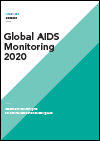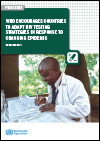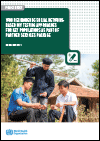What's New
Displaying results 921 - 930 of 4913

Resource | Publications,
Any woman with an unwanted pregnancy who cannot access safe abortion is at risk of unsafe abortion. Women living in low-income countries and poor women are more likely to have an unsafe abortion than more affluent women. Deaths and injuries are higher when unsafe abortion is performed later in pregnancy. The rate of unsafe abortions is higher where access to effective contraception and safe abortion is limited or unavailable.

Resource | Publications,
STIs have a profound impact on sexual and reproductive health worldwide. More than 1 million sexually transmitted infections occur every day. Each year, an estimated 376 million infections occur with one of four curable STIs: chlamydia, gonorrhoea, syphilis and trichomoniasis. More than 500 million people are living with genital herpes infection. Approximately 300 million women have HPV infection and numbers among men are likely as high.

Resource | Publications,
The health sector has an important role to play in addressing violence against women by providing comprehensive health services including for sexual and reproductive health, providing referrals to other support services; gathering evidence through data and research; fostering prevention policies in other sectors; and advocating for violence against women to be recognized as a public health problem and for resource allocation.

Global AIDS Monitoring 2020: Indicators for Monitoring the 2016 Political Declaration on Ending AIDS
Resource | Publications,
The purpose of this document is to provide guidance to national AIDS programmes and partners on the use of indicators to measure and report on the country HIV response.
The 2016 Political Declaration on Ending AIDS was adopted at the United Nations (UN) General Assembly High-Level Meeting on AIDS in June 2016. Built on three previous political declarations—the 2001 Declaration of Commitment on HIV/AIDS, the 2006 Political Declaration on HIV/AIDS and the 2011 Political Declaration on HIV and AIDS: Intensifying Our Efforts to Eliminate HIV and AIDS—the 2016 Political Declaration on Ending AIDS mandates UNAIDS to support countries in reporting on the commitments it contains.

Resource | Guidelines,
These consolidated guidelines bring together existing and new evidence-based guidance and recommendations for delivering high-impact HIV testing services, including linkage to HIV prevention and treatment, in diverse settings and populations.
A key objective of these guidelines is to encourage greater national and global commitment to implementing effective and efficient HTS as a vital element of the national and global HIV response, essential to achieving and maintaining low HIV incidence.

Resource | Publications,
WHO recommends that pregnant women receive testing for HIV, syphilis and hepatitis B (HBSAg) at least once during pregnancy, preferably in the first trimester.
Dual HIV/syphilis rapid diagnostic tests (RDTs) can be used as the first test for pregnant women as part of antenatal care (ANC).
These simple tests can be used at the point-of-care and are cost-saving compared to standard testing in ANC. They enable more women to be diagnosed with HIV and syphilis so that they can access treatment and prevent transmission to their children.

Resource | Publications,
HIV testing services (HTS) and anti-retroviral therapy (ART) have been scaled up substantially. It is estimated that, globally, nearly 80% of people with HIV now know their status. With the offer of immediate ART initiation and improved treatment options, access to and uptake of treatment have increased, too. Now, most people with HIV who know their status are obtaining treatment and care.
In response to these changes in the global HIV epidemic, WHO is encouraging countries to use three consecutive reactive tests for an HIV-positive diagnosis as their treatment-adjusted prevalence and national HTS positivity fall below 5%.

Resource | Publications,
HIV self-testing (HIVST) is a convenient and confidential option for HIV testing. In 2016 WHO recommended HIVST as a safe, accurate and effective way to reach people who may not test otherwise, including people from key populations, men and young people. Lay users can perform HIVST reliably and accurately and achieve performance comparable to that of trained health-care workers.
Globally, many countries have developed HIVST policies, and implementation is growing rapidly. This policy brief highlights new guidance to optimize HIVST implementation, including effective service delivery models, linkage to care and support tools.

Resource | Publications,
Social network-based HIV testing is an approach for engaging sexual and drug injecting partners and social contacts of key population members with HIV and of those who are HIV-negative and at ongoing risk in voluntary HTS.
By addressing people’s confidentiality concerns and broadening the reach to social contacts, social network-based HIV testing approaches can improve the acceptability of partner services among key populations and so reach more people who may not otherwise test for HIV. WHO now recommends that social network-based HIV testing approaches can be offered for key populations.

Resource | Publications,
Globally, one in five people with HIV are unaware of their status, despite considerable scale up of HIV testing, treatment and prevention services. Many of those unreached by HIV testing services (HTS) are from key populations, partners of people with HIV and, in Eastern and southern Africa, men and young people. Improving the availability, accessibility, friendliness and quality of services is important to address these testing gaps.
At the same time, tools and interventions that increase the demand for HTS are needed to reach people who are uninformed about HTS options and advances in treatment and prevention, people who are not motivated to seek HTS and those who are hesitant to test because of fear of an HIV diagnosis or other reasons.





